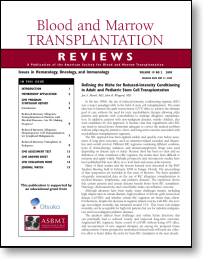
Defining the Niche for Reduced-Intensity Conditioning in Adult and Pediatric Stem Cell Transplantation
by Jan S. Moreb, MD, John R. Wingard, MD, Editor
In the late 1990s, the use of reduced-intensity conditioning regimen (RIC) was a major paradigm shift in the field of stem cell transplantation. The main idea was to harness the graft-versus-tumor (GVT) effect to achieve the ultimate goal of cure without the need for toxic myeloablative therapy, allowing older patients and patients with comorbidities to undergo allogeneic transplantation. In addition, patients with non-malignant diseases, mainly children, also were candidates for this approach. It became clear that engraftment after RIC can result in mixed donor chimerism adequate to correct the medical problem without subjecting the patient to short- and long-term toxicities associated with myeloablative transplantation regimens.
The RIC approach has been applied widely and quickly even before assesment of long-term outcomes, such as treatment-related mortality and diseasefree and overall survival. Different RIC regimens containing different combinations of chemotherapy, radiation, and immunosuppressive drugs were used depending on disease type or status. Because there has been no clear and set definition of what constitutes a RIC regimen, the results have been difficult to interpret and apply widely. Multiple prospective and retrospective studies have been published that now allow us to look back and assess achievements.
Treatment selection is made even more difficult by individual patient factors, especially comorbidities. For example, a frail elderly person who struggles with ambulation due to arthritis could face severe threat from a regimen that causes neuropathy, even though that regimen may be more effective against multiple myeloma.
Many of these studies and the lessons learned were discussed at the BMT Tandem Meeting held in February 2009 in Tampa, Florida. The proceedings of that symposium are included in this issue of Reviews. The three speakers eloquently summarized data on the use of RIC allogeneic transplantation in myeloid diseases, lymphomas, and pediatric diseases. The experience shows that certain patients and certain diseases benefit better from RIC transplants. Histology, chemosensitivity, and comorbidity index can influence outcome.
Many of these studies and the lessons learned were discussed at the BMT Tandem Meeting held in February 2009 in Tampa, Florida. The proceedings of that symposium are included in this issue of Reviews. The three speakers eloquently summarized data on the use of RIC allogeneic transplantation in myeloid diseases, lymphomas, and pediatric diseases. The experience shows that certain patients and certain diseases benefit better from RIC transplants. Histology, chemosensitivity, and comorbidity index can influence outcome.
Although advances have been made, many challenges remain, including high relapse rates in certain diseases, high incidence of chronic graft-versus-host disease (cGVHD), and whether certain RIC regimens are better than others. Furthermore, despite the decrease in regimen related toxicity with RIC, the average non-relapse mortality has remained around 15%. This lower non-relapse mortality can be acceptable for high risk patients but not for indolent malignancies and non-malignant pediatric diseases.
The speakers address these challenges and outline future directions that can potentially lead to reduced toxicity and improved long-term outcomes. Augmented RIC regimens, better control of cGVHD without losing GVT effect, and incorporation of new targeted therapies are among the proposed future enhancements. Future prospective randomized clinical trials will need our collective effort to better define the niche for these RIC transplants in the next decade.
Download a PDF version of the full issue.
